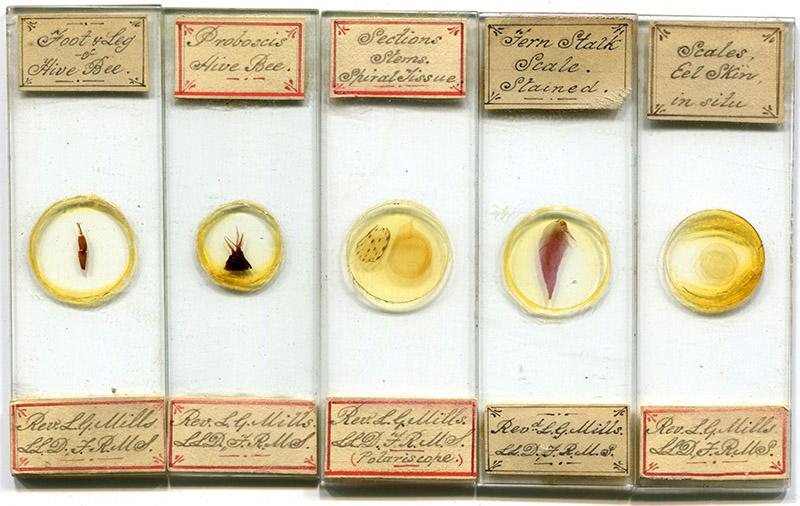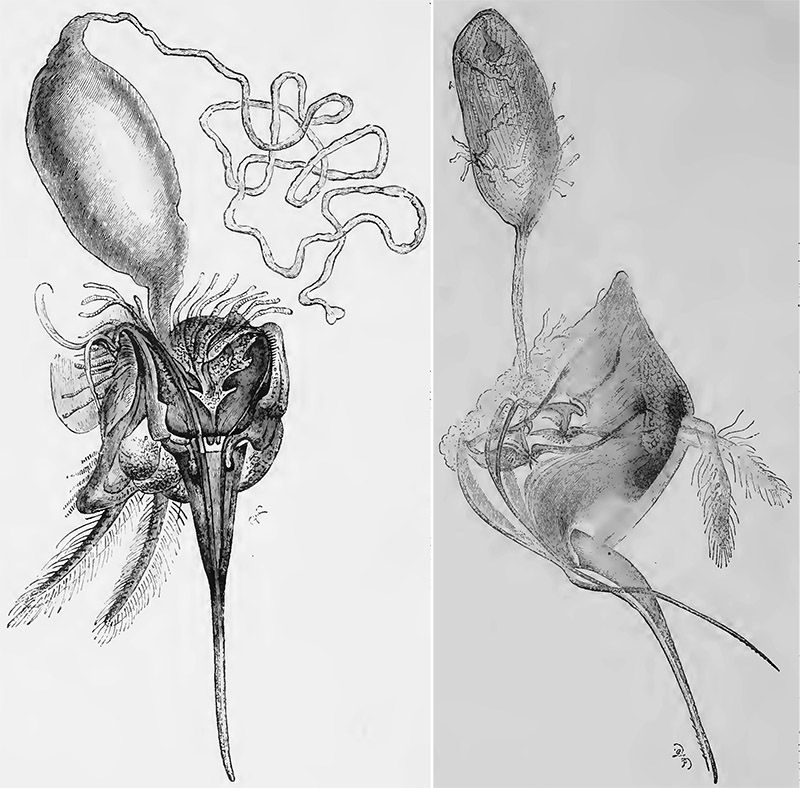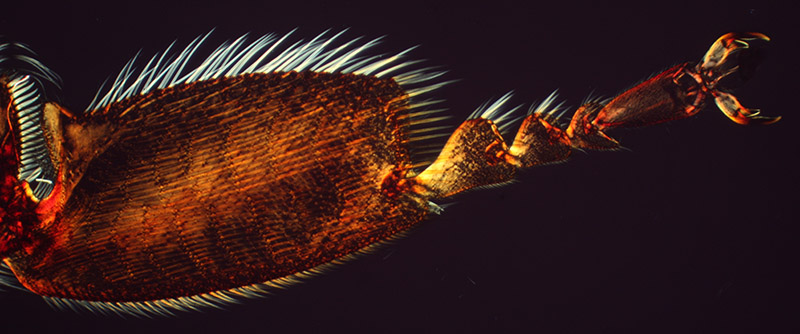
Figure 1. Examples of microscope slides that were produced by Lewis G. Mills. He became a Fellow of the Royal Microscopical Society in 1876.
Reverend Lewis George Mills, 1823 - 1885
by Brian Stevenson
last updated June, 2016
This amateur microscopist’s neatly-finished slides are especially notable for Mills’ elegant handwriting (Figure 1). The abundance of slides with Mills’ name written on labels suggests that many were shared with colleagues. Although he evidently lived his whole life in Ireland, Mills was a Fellow of the Royal Microscopical Society, so exchanges with other members likely account for the number of Mills’ slides found in England.
In addition to making microscope slides, Mills was a skillful artist. Figures 2 and 3 show some of his drawings that accompanied published papers.

Figure 1.
Examples of microscope slides that were produced by Lewis G. Mills. He became a Fellow of the Royal Microscopical Society in 1876.
L.G. Mills was born in 1823, in County Longford, Ireland. Little else is currently known about his personal life. The probate of his will was proved by Emily Jane Mills “of Creggan Rectory Spinster one of the Executrixes”. Emily’s unmarried stature suggests that she may have been Lewis’ daughter.
He obtained B.A., LL.B. and LL.D degrees from Trinity College, Dublin. His education can be tracked by noting records about him and his publications. In 1861, he was recorded as being Secretary of the Armagh Natural History and Philosophical Society, and was listed as “Mr. L.G. Mills”, whereas the President was listed as “Rev. T.R. Robinson, D.D.” Reports from 1866 through 1870 described him as “Lewis G. Mills, LL.B.”. An 1874 publication was signed “Lewis G. Mills, LL.D.”
Mills served as headmaster of Armagh Cathedral School from 1850-1873. In 1868, he was listed as Schoolmaster of the Choristers of St. Patrick’s, for which he received “a salary of £80, together with a free house. The Choristers are instructed by him in English, Mathematics, and Classics”. Mills also served as Curate of Aghavilly Parish from 1871 to 1873, then as Rector of Craggan Parish from 1873 until his death. The rectorship coincided with Mills obtaining his LL.D. degree.
He evidently had a long-standing interest in the sciences. Mills was the Secretary of the Armagh Natural History and Philosophical Society in 1861, implying that he had already been a member for some time.
Lewis Mills’ publications on science indicate a strong interest in microscopy, and provided great detail on mounting methods, and dissections of insects and spiders. He was also a skilled graphic artist, and his writings were frequently accompanied by his drawings (e.g. Figures 2 and 3).
In 1869, Mills presented a lecture to the Armagh Natural History and Philosophical Society "On the manipulation and preparation of objects for the microscope". He “gave a lengthened explanation of usual methods adopted in the preparation of microscopic objects of different kinds”.
Mills’ skill as a mounter, and his detailed written descriptions, led to his being quoted in the second, 1873 edition of Thomas Davies’ Preparation and Mounting of Microscopic Objects. That edition was extensively revised and amended by John Matthews, due to Davies’ debilitating illness. He wrote, “Mr. Lewis G. Mills, LL.B., gives the following account of his extracting the poison glands from a spider: Having killed a large spider with chloroform, I left it in water for seven or eight days. This treatment usually softens the outer skin of insects and causes the viscera to swell, so as to burst through the outer integument, and it is in this state, perhaps, that the poison glands are most easily discovered and traced to their points of attachment. I then drew the mandibles from the body, and, having placed them with a little water on a slide and covered them with a piece of thin glass, I found that, upon the application of pressure, the two glands shot out and protruded from the bases of the mandibles. I tore open one of the mandibles with needles, so as to disturb the gland as little as possible. The gland then appeared as a closed sac, attached by a hollow cord, about the length of the gland itself, to the base of the fang, where also was a large bundle of muscular fibre”, and “Amongst insects, especially the grasshopper tribe, are found many which possess a gizzard, armed with strong teeth, somewhat similar to those of the molluscs. It requires great nicety of manipulation to obtain these for the microscope; but Mr. L.G. Mills, before quoted, gives the following instructions: Kill the insect with chloroform and place it in a vessel of water. Hold it down firmly with a pair of tweezers, and with the back of a dissecting knife draw the head steadily from the body. The head brings with it the stomach, gizzard, and chief portion of the digestive tubes. Place all these under a dissecting microscope, when the gizzard, being just below the stomach and darker in colour, is easily distinguished, and may be separated by two cuts with the knife. It then forms a short tube, the teeth being inside. The opening-out of this tube, especially if it be small, requires delicate handling; if the point of a tine knife can be fairly inserted, then one firm cut downward upon the glass will lay open the gizzard. Here great care is needed; and sometimes it is well to put a fine needle up the tube, and cut down upon the needle. Among the small weevils the membrane is delicate, so that great care is necessary”.
Lewis Mills was elected to membership in the Royal Microscopical Society in March, 1876. Thus, slides labeled with the initials F.R.M.S. date from 1876 and later (Figure 1).
It is not clear whether Mills actually attended any RMS meetings in London. A paper of his, on diatoms from Peruvian guano, was presented to the RMS on November 9, 1881, but it is clear from the published follow-up discussion that Mills was not actually in the room.
Lewis Mills died on May 28, 1885, at his home, the Craggan Rectory. He was 62 years old.

Figure 2.
Lewis G. Mills’ illustrations of the sting and poison sac and gland of a humble bee (left) and wasp (right). Adapted from his 1868 publication on those topics.

Figure 3.
“Teeth” on the proboscis of a blow-fly, by L.G. Mills, 1878.

Figure 4.
Foot and leg of a hive bee, mounted by L.G. Mills, ca. 1880 (see Figure 1). Photographed with a C-mounted digital SLR camera, a 3.4x objective lens, and crossed polarizing filters.

Figure 5.
“Sections, stems. Spiral tissue”, by L.G. Mills, ca. 1880 (see Figure 1). Photographed with a C-mounted digital SLR camera, a 10x objective lens, and crossed polarizing filters.
Resources
Davies, Thomas, and John Matthews (1873) The Preparation and Mounting of Microscopic Objects, Second Edition, Hardwicke and Bogue, London, pages 168 and 173-174
Inscriptions in Creggan Graveyard, section 1 (accessed June, 2016) http://www.cregganhistory.co.uk/CregGui1a.htm
Kitton, F. (1882) Note on the Rev. G. L. Mills Paper on diatoms from Peruvian Guano, Journal of the Royal Microscopical Society, Series 2, Vol. 2. pages 476-477
Mills, Lewis G. (1866) The house spider, Hardwicke’s Science-Gossip, Vol. 2, page 7
Mills, Lewis G. (1866) Proboscis of blow-fly, Hardwicke’s Science-Gossip, Vol. 2, page 23
Mills, Lewis G. (1866) Poison-glands of spiders, Hardwicke’s Science-Gossip, Vol. 2, page 229
Mills, Lewis G. (1866) Gastric teeth of insects, Hardwicke’s Science-Gossip, Vol. 2, page 249
Mills, Lewis G. (1867) The wasp’s sting, its poison gland, Hardwicke’s Science-Gossip, Vol. 3, page 60
Mills, Lewis G. (1867) Processes and inflations in diatoms, Hardwicke’s Science-Gossip, Vol. 3, page 103
Mills, Lewis G. (1868) Stings and poison glands of bees and wasps, Hardwicke’s Science-Gossip, Vol. 4, pages 148-152
Mills, Lewis G. (1869) The winter home of the humble bee, Hardwicke’s Science-Gossip, Vol. 5, page 41
Mills, Lewis G. (1869) Hibernation of the humble bee, Hardwicke’s Science-Gossip, Vol. 5, page 134
Mills, Lewis G. (1874) Stings of wasps and bees, Hardwicke’s Science-Gossip, Vol. 9, pages 50-51
Mills, Lewis G. (1878) The teeth of the blow-fly, Hardwicke’s Science-Gossip, Vol. 14, pages 147-150
Mills, Lewis G. (1881) Diatoms from Peruvian Guano, Journal of the Royal Microscopical Society, Series 2, Vol. 1. pages 884-887
The Monthly Microscopical Journal (1869) Natural History Society Of Armagh, “The last meeting of this Society was held on the 13th January, Mr. A. J. Mulligan in the chair. Mr. Lewis G. Mills, LL.B., delivered a lecture ‘On the Manipulation and Preparation of Objects for the Microscope’. The lecturer stated that of the large number of those who possessed microscopes, but few were able to prepare good slides, and these persons were chiefly dependent upon professional preparers for properly mounted objects. He then showed how that such unskilled preparers might turn their microscopes to good account by using them in the study of objects which required little manipulation and no preparation. The lecturer then gave a lengthened explanation of usual methods adopted in the preparation of microscopic objects of different kinds. In speaking of the mode of mounting diatoms from fossil deposits, he strongly recommended the method of selection as giving the best attainable results from unpromising deposits. His observations on the treatment of guano were to this effect:—" The guano most readily obtained is the common Peruvian guano of commerce; in this deposit the diatoms form a very small percentage of the entire mass, and to prepare the deposit for mounting in the rough, according to the usual process, would generally give very poor results, and discourage all except those well skilled in manipulation. However, the most unproductive samples of guano contains some diatoms, and fair slides may be prepared from the material, if the process of selection be adopted in their preparation. For this process, it is not needful to use more nitric acid in the previous cleaning than that which may be necessary to clean the diatoms themselves; and the use of sulphuric acid and chlorate of potash is not required, as the bleaching of the unsightly foreign material would be useless. A large drop of the prepared material must be spread near the edge of a glass slide: the appearance of this under a simple microscope with a glass of one-inch focus will be that of much dirty material containing a few clean diatoms: the best of these latter may be pushed out of the water by means of a needle, and nicely arranged near the centre of the slide. The slide may now be raised, and the water may be carefully wiped off; the turning of the slide on its edge, or the wiping away of the water will not disturb the diatoms selected and placed, as they remain attached to the glass sufficiently firmly to admit of the movements required. In this way the choice diatoms may be selected out of many drops, and be perfectly free from an unsightly speck of the half-cleaned foreign material. The diatoms to be obtained from Peruvian guano will vary, within certain limits, with the different samples of the guano. The common forms of Coscinodiscus may always be found; Eudycta oceanica often; Aulacodiscus scaber frequently; sometimes Auliscus peruvianus may be obtained. From many different trials I found twice a form which I take to be Aulacodiscus Petersii, and once only Auliscus ovalis. These I have on clean slides, and for them and the clean mounting I believe I am indebted to the process of selection which I have endeavoured briefly to describe, and but for which process the material from which they were taken might have been thrown away as useless. It is needless to say, that in deposits where the diatoms are small and very numerous, as also in pure gatherings of living diatoms, the process of selection is out of the question; but in working the Moron deposit, the different kinds of guano, shell cleanings, and others, it will be found to be of the greatest utility", page 139
The Monthly Microscopical Journal (1876) “The Rev. Lewis G. Mills, LL.D., was elected a Fellow of the Society”, page 164
Probate of Lewis George Mills (1885) Accessed through familysearch.org
Report of Her Majesty's Commissioners on the Revenues and Condition of the Established Church (Ireland) (1868) Her Majesty’s Stationery Office, Dublin
Rogers, Edward (1861) A Record of the City of Armagh From the Earliest Period to the Present Time, Armagh Guardian Office
Scientific Opinion (1870) Armagh Natural History and Philosophical Society, “The concluding lecture of this season was delivered by L.G. Mills, Esq., LL.B., in the Society's House, on last Wednesday evening, the Rev. Henry C. Irvine in the chair. After transacting the ordinary business, the chairman called on Mr. Mills, who proceeded with his lecture on ‘The Spider’, which he delivered with his accustomed ability. Several curious objects were exhibited through the Society's microscope, and a general conversation ensued on various matters bearing on the spider, its home and habits. On the motion of Thomas Smith, Esq., seconded by J.L. Riggs, Esq., M.D., the chairman presented to Mr. Mills the thanks of the meeting for his interesting address”, Vol. 3, page 534
West, Tuffen (1885) Half-an-hour at the microscope, “Crystals of Oxalic Acid. I am quite sure of the correctness of my proposition in this case, which, for anything that here appears, might just as well be crystals of any other salt, so many, when rapidly crystallised from weak solutions, form just such as we see here, and which have nothing whatever of the forms whereby crystals of oxalic acid, or salts isomeric with it, may be recognised when present. Our readers may remember some interesting descriptions, with figures by Lewis G. Mills, LL.B., of Armagh, of crystals found by him in the fang of a spider and in the sting of a wasp. The accounts of these appeared in parts of Science Gossip of a few years ago, and I have myself remarked in these ‘Notes’ on similar crystals present on a slide of ‘Sting of Scorpion’. These, though probably not exactly oxalic acid, were ‘isomeric’ - that is, identical in form with the typical crystals of that salt, and, as I have already pointed out, illustrate well the application of the polariscope as an adjunct, at times of much importance in scientific investigation”, Journal of Microscopy and Natural Science, Vol. 4, page 114